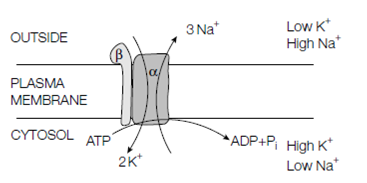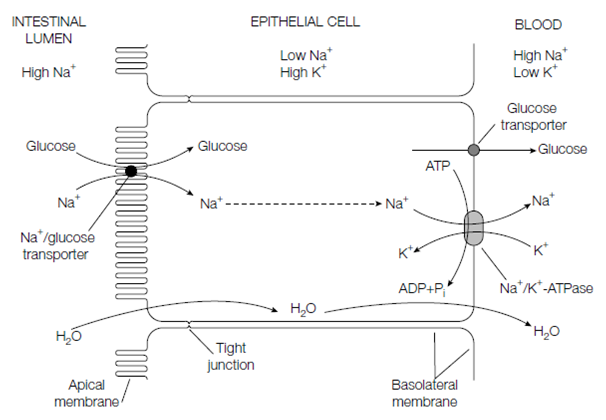Glucose transport into intestinal epithelial cells
The cells lining the lumen of the intestine are polarized, which is they have two distinct sides or domains that have different lipid and protein compositions. The brush or apical border membrane facing the lumen is highly folded into microvilli to raise the surface field available for the absorption of nutrients. The other of the plasma membrane the basolateral surface is in contact with neighboring the blood and cells capillaries. Movement among adjacent

Figure: The Na+ /K+ -ATPase, shown as an αβ heterodimer.

Figure: Ion-driven cotransport mechanisms. (a) Symport process involving a symporter (e.g. Na /glucose transporter); (b) antiport process involving an antiporter (e.g. erythrocyte band 3 anion transporter).
epithelial cells is prevented through the formation of tight junctions around the cells near the apical domain. Therefore any nutrient molecules in the lumen of the intestine have to pass through the cytosol of the epithelial cell in order to enter the blood.
Glucose (or other sugars and amino acids) are transported across the apical membrane from a relatively low concentration in the lumen of the intestine to a relatively high concentration in the cytosol of the epithelial cell through a glucose/Na+ symporter protein in the above Figure. This is a form of ion-driven active transport; the energy for the movement of glucose against its concentration gradient comes from the movement of Na+ down its concentration gradient. The blood flowing by the capillaries on the basolateral side of the epithelial cell maintains a concentration gradient of glucose across this membrane allowing the glucose to move out of the cell by facilitated diffusion through a glucose transporter (a uniporter) which is similar to the erythrocyte glucose transporter (see above). The relatively low concentration of Na+inside the epithelial cell is maintained by a Na+ /K+-ATPase (see above) on the basolateral membrane and an instance of ATP-driven active transport in figure.

Figure: Transport of glucose and water across intestinal epithelial cells.